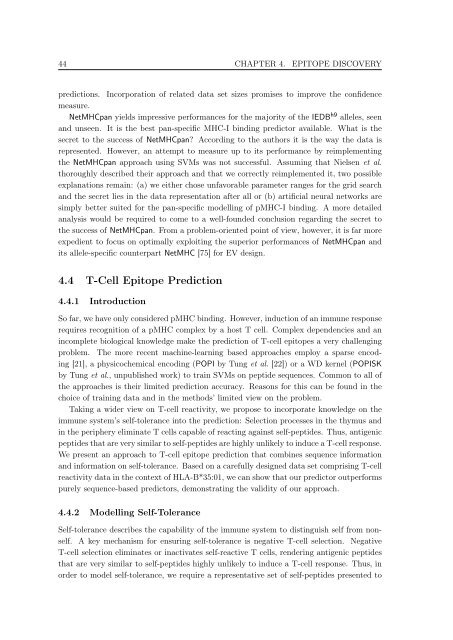New Approaches to in silico Design of Epitope-Based Vaccines
New Approaches to in silico Design of Epitope-Based Vaccines
New Approaches to in silico Design of Epitope-Based Vaccines
Create successful ePaper yourself
Turn your PDF publications into a flip-book with our unique Google optimized e-Paper software.
44 CHAPTER 4. EPITOPE DISCOVERY<br />
predictions. Incorporation <strong>of</strong> related data set sizes promises <strong>to</strong> improve the confidence<br />
measure.<br />
NetMHCpan yields impressive performances for the majority <strong>of</strong> the IEDB h9 alleles, seen<br />
and unseen. It is the best pan-specific MHC-I b<strong>in</strong>d<strong>in</strong>g predic<strong>to</strong>r available. What is the<br />
secret <strong>to</strong> the success <strong>of</strong> NetMHCpan? Accord<strong>in</strong>g <strong>to</strong> the authors it is the way the data is<br />
represented. However, an attempt <strong>to</strong> measure up <strong>to</strong> its performance by reimplement<strong>in</strong>g<br />
the NetMHCpan approach us<strong>in</strong>g SVMs was not successful. Assum<strong>in</strong>g that Nielsen et al.<br />
thoroughly described their approach and that we correctly reimplemented it, two possible<br />
explanations rema<strong>in</strong>: (a) we either chose unfavorable parameter ranges for the grid search<br />
and the secret lies <strong>in</strong> the data representation after all or (b) artificial neural networks are<br />
simply better suited for the pan-specific modell<strong>in</strong>g <strong>of</strong> pMHC-I b<strong>in</strong>d<strong>in</strong>g. A more detailed<br />
analysis would be required <strong>to</strong> come <strong>to</strong> a well-founded conclusion regard<strong>in</strong>g the secret <strong>to</strong><br />
the success <strong>of</strong> NetMHCpan. From a problem-oriented po<strong>in</strong>t <strong>of</strong> view, however, it is far more<br />
expedient <strong>to</strong> focus on optimally exploit<strong>in</strong>g the superior performances <strong>of</strong> NetMHCpan and<br />
its allele-specific counterpart NetMHC [75] for EV design.<br />
4.4 T-Cell Epi<strong>to</strong>pe Prediction<br />
4.4.1 Introduction<br />
So far, we have only considered pMHC b<strong>in</strong>d<strong>in</strong>g. However, <strong>in</strong>duction <strong>of</strong> an immune response<br />
requires recognition <strong>of</strong> a pMHC complex by a host T cell. Complex dependencies and an<br />
<strong>in</strong>complete biological knowledge make the prediction <strong>of</strong> T-cell epi<strong>to</strong>pes a very challeng<strong>in</strong>g<br />
problem. The more recent mach<strong>in</strong>e-learn<strong>in</strong>g based approaches employ a sparse encod<strong>in</strong>g<br />
[21], a physicochemical encod<strong>in</strong>g (POPI by Tung et al. [22]) or a WD kernel (POPISK<br />
by Tung et al., unpublished work) <strong>to</strong> tra<strong>in</strong> SVMs on peptide sequences. Common <strong>to</strong> all <strong>of</strong><br />
the approaches is their limited prediction accuracy. Reasons for this can be found <strong>in</strong> the<br />
choice <strong>of</strong> tra<strong>in</strong><strong>in</strong>g data and <strong>in</strong> the methods’ limited view on the problem.<br />
Tak<strong>in</strong>g a wider view on T-cell reactivity, we propose <strong>to</strong> <strong>in</strong>corporate knowledge on the<br />
immune system’s self-<strong>to</strong>lerance <strong>in</strong><strong>to</strong> the prediction: Selection processes <strong>in</strong> the thymus and<br />
<strong>in</strong> the periphery elim<strong>in</strong>ate T cells capable <strong>of</strong> react<strong>in</strong>g aga<strong>in</strong>st self-peptides. Thus, antigenic<br />
peptides that are very similar <strong>to</strong> self-peptides are highly unlikely <strong>to</strong> <strong>in</strong>duce a T-cell response.<br />
We present an approach <strong>to</strong> T-cell epi<strong>to</strong>pe prediction that comb<strong>in</strong>es sequence <strong>in</strong>formation<br />
and <strong>in</strong>formation on self-<strong>to</strong>lerance. <strong>Based</strong> on a carefully designed data set compris<strong>in</strong>g T-cell<br />
reactivity data <strong>in</strong> the context <strong>of</strong> HLA-B*35:01, we can show that our predic<strong>to</strong>r outperforms<br />
purely sequence-based predic<strong>to</strong>rs, demonstrat<strong>in</strong>g the validity <strong>of</strong> our approach.<br />
4.4.2 Modell<strong>in</strong>g Self-Tolerance<br />
Self-<strong>to</strong>lerance describes the capability <strong>of</strong> the immune system <strong>to</strong> dist<strong>in</strong>guish self from nonself.<br />
A key mechanism for ensur<strong>in</strong>g self-<strong>to</strong>lerance is negative T-cell selection. Negative<br />
T-cell selection elim<strong>in</strong>ates or <strong>in</strong>activates self-reactive T cells, render<strong>in</strong>g antigenic peptides<br />
that are very similar <strong>to</strong> self-peptides highly unlikely <strong>to</strong> <strong>in</strong>duce a T-cell response. Thus, <strong>in</strong><br />
order <strong>to</strong> model self-<strong>to</strong>lerance, we require a representative set <strong>of</strong> self-peptides presented <strong>to</strong>

















